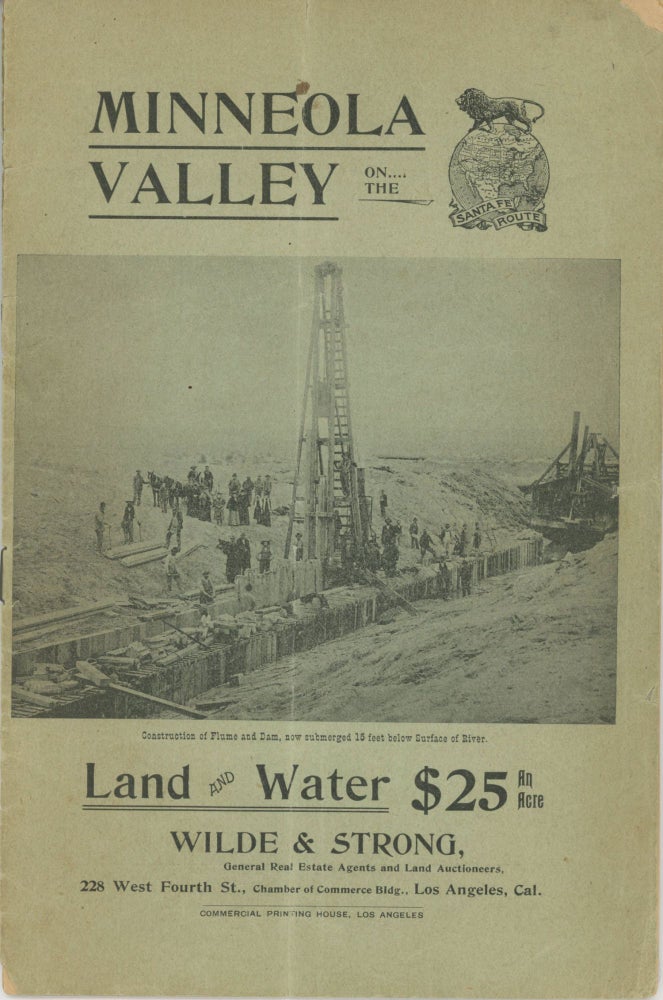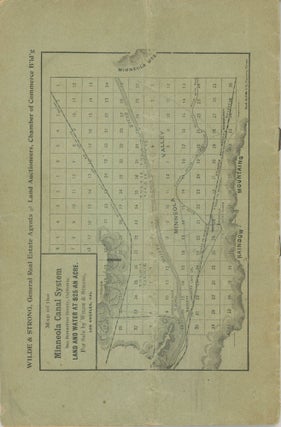MINNEOLA VALLEY ON THE SANTA FE ROUTE ... LAND AND WATER $25 AN ACRE. Wilde & Strong, General Real Estate Agents and Land Auctioneers, 228 West Fourth St., Chamber of Commerce Bldg., Los Angeles, California. Los Angeles: Commercial Printing House, n.d. [1896]. 22.2x14.5 cm, pp. 1-12, 2 illustrations (on front and inside front wrapper) and 2 maps (on rear and inside rear wrapper), original pictorial gray wrappers printed in black, stapled. First edition. A prospectus for an incredibly risky land scheme in San Bernardino County issued by Wilde & Strong, General Real Estate Agents and Land Auctioneers. Promotes land along the Minneola Canal (owned by the Southern California Improvement Company) being dredged to bring water to desert land. The two maps are: "Map of the Minneola Canal System ..." on the rear cover, and "Map of Southern California Showing Location of Minneola Valley and Surrounding Country" on the inside of the rear wrapper. An article "Minneola Canal System All Right" in the January 1896 “Rural Californian” sheds light on the project: "The Southern California Improvement Co., who are building the Minneola Canal in San Bernardino County, have been greatly handicapped by the stringent financial times. They nevertheless succeeded in partially completing their irrigation system and have developed over 1500 inches of water and felt hopeful of obtaining sufficient funds to complete the work which will assure them unquestionably an additional 4000 inches. Being much pressed by some smaller creditors, and legal proceedings having been instituted in some cases, it was deemed advisable to place the property in the hands of a Receiver. This was so ordered at the request of the Receiver of the Atlantic and Pacific Railway who held a mortgage of $20,000 and Mr. F. C. Guy general freight agent of the Southern California Railway was appointed as such. This step has been taken entirely in the interest of both the Company and the creditors and is a friendly suit. It is contemplated to reorganize and place every creditor on an equal footing. In the meanwhile the Receiver will complete the work. Considerable water rights have been sold while the liabilities are in the neighborhood of $77,000, and the assets are from $450,000 to $500,000. Wilde & Strong are the General Agents for the sale of water rights of this Company. They have shown their faith in this development by purchasing about 800 inches of water. These water rights are not subject to mortgage or other encumbrances and are not in any way affected by the temporary embarrassment of the above company. The only interest this Company retains in its water rights sold is the annual rental for the delivery or distribution of the water during the irrigating season." However, the Minneola System was not "all right." In 1901 a complaint was entered at the office of the San Bernardino County Clerk "against Minnie Dieterle and her husband, William Dieterle, the Minneola Town Company and others, for the collection of a note for $2375, dated Los Angeles. May 25, 1896, signed by Minnie and her husband and secured. Nothing had been paid on either principal or interest on the note. The note was secured by deed of water from the Minneola canal and mortgage on the town site of Minneola ... This is the final roundup of what was one of the wildest land boom schemes that ever took in the tenderfoot in Southern California. The only water was to come from the undertow of the Mojave River, after it sinks in the sand, and after spending all the money available in dredging a canal in the sand passing the town of Dagget on the desert, the water was insufficient to supply any demands upon it, and the dupes who invested in the town of Minneola, named after 'Minnie,' on the note, the town went back to the desert again. At one time it was a school district, with a dozen or more pupils, but as that was part of the boom scheme it did not last long. The town site lies on the Santa Fe a few miles east of Daggett, and corner lots, including the site of the 'University' and elegant tourist hotel and high school, can be purchased very reasonably at present. The whole was a boom bubble" (The San Bernardino County Sun, 7 February 1901, p. 7). "Water is essential to life in the desert, and as the population of non-miners grew, locals began thinking of diversifying into agriculture to keep the area alive. In anticipation, they began a program to carry water from the Mojave River toward Daggett through a dam and ditch system. Today the Daggett Ditch, also known as the Minneola Canal, is one of the oldest historic irrigation projects on the Mojave River. The Mojave River is largely an underground waterway, with water flowing beneath the sand and rarely visible at the surface; it is sometimes referred to as the “Upside-Down River.” In 1893, a company was formed to try to build a submerged dam that would impound and then divert water into an irrigation ditch. Stock for the new company was issued, on the premise that water would generate electricity to sell to the mines and mills at Calico and pay for the ditch, thereby providing the farmers and citizens of Daggett with a free supply of water. Homesteading claims for over 1,800 acres of land were filed with the federal government in anticipation of the new water system. Even though the dam was built, the project failed, creating less than three percent of what was needed to realize those high hopes. In 1901, four individuals, including Theodore Strong Van Dyke and his son Dix Van Dyke, formed a new company and started to improve the old dam and line the old Daggett Ditch. Through their efforts, they were able to bring irrigation to 320 acres of new farm land east of Daggett (including the Van Dykes’ ranch) by 1902. This was the first large area to be irrigated in the Mojave Desert. The dam was located in the Mojave River northeast of the Marine Corps Logistics Base today. The earthen ditch delivered water ten miles from the dam and its associated artesian wells to irrigate orchards and alfalfa fields in the six miles between Minneola and Daggett. With the addition of water, the Van Dyke ranch became the first place in California after leaving the Colorado River to find hay and alfalfa for teams of horses and a popular stop for travelers" (Cindy Baker, History of Dagget, PAR Environmental Services, Inc.). Not in Rocq. Vertical center crease where folded for mailing, wrappers worn at edges, a good copy of a very fragile production. No copies are listed in OCLC. CU-B has a photocopy. Rare. (#166347).
Price: $850.00
No statement of printing.



